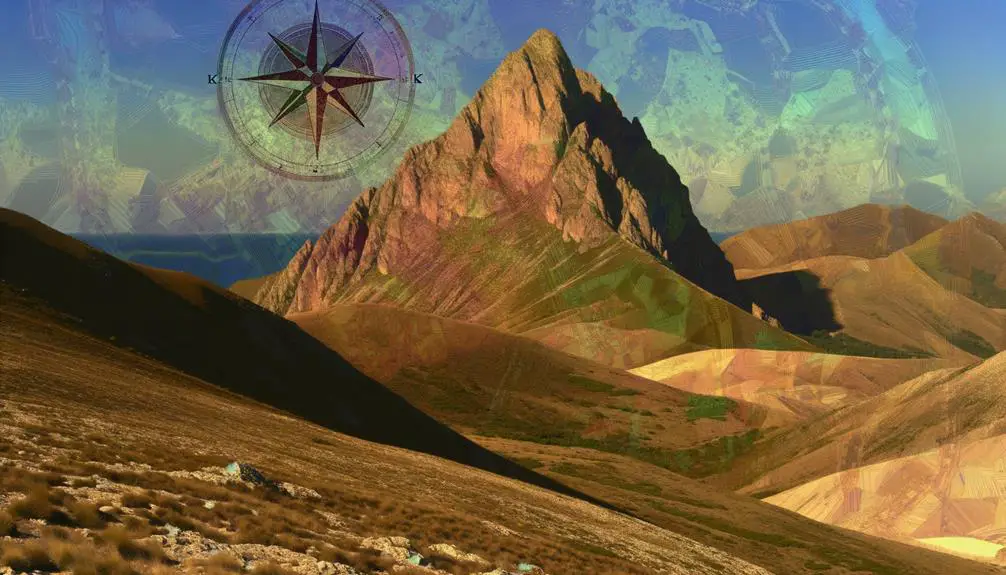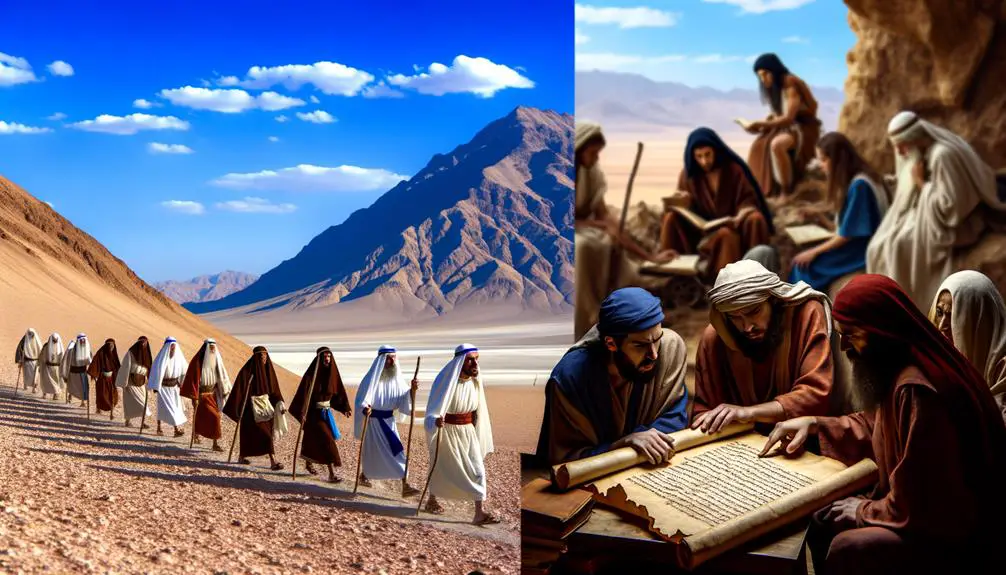Yielding profound spiritual secrets, Mt. Paran in the Bible serves as a lesser-known site of divine encounters and prophetic revelations.

Mt Paran in the Bible
Have you ever wondered why Mt. Paran holds such a mysterious allure in biblical scripture? Nestled in the narrative of ancient texts, its significance is often overshadowed by more prominent locations.
Yet, Mt. Paran is a fascinating site, not just for its geographical stance but for the profound spiritual events it hosted. From divine encounters to prophetic revelations, its role is subtly pivotal.
As you explore further, you'll uncover layers of historical and spiritual significance that might just shift your understanding of biblical events and locations. Why does Mt. Paran merit a closer look, and what secrets does it hold? Let's find out together.
Key Takeaways
- Mt. Paran is referenced in biblical passages, highlighting its spiritual importance in divine narratives and guidance.
- The location of Mt. Paran, debated among scholars, lies possibly in the Sinai Peninsula or northwestern Arabia.
- Archaeological and historical research on Mt. Paran enriches understanding of its significance in biblical and spiritual contexts.
- Mt. Paran symbolizes divine presence and prophetic revelations, fostering spiritual growth and encounters for believers.
The Location of Mt. Paran

Mt. Paran's exact location frequently sparks debate among scholars, yet it's generally identified within the northeastern Sinai Peninsula or the northwestern Arabian desert. This geographical ambiguity fuels ongoing discussions and research, as you delve into the historical and biblical contexts that hint at its whereabouts. The geographical debates surrounding Mt. Paran aren't just academic exercises; they're pivotal in understanding the historical and cultural backdrop of biblical narratives.
You'll find that archaeological findings play a crucial role in these discussions. While direct evidence pinpointing Mt. Paran's location remains elusive, related discoveries provide clues that help narrow down the possibilities. For example, artifacts and settlement patterns in the Sinai Peninsula and northwestern Arabia offer insights into ancient nomadic routes and habitation areas, which in turn shed light on potential locations for Mt. Paran. These findings, although not definitive, contribute significantly to the scholarly discourse, offering a tangible connection to the elusive mountain.
The analytical approach to determining Mt. Paran's location involves a meticulous examination of historical texts, geographical records, and archaeological evidence. You must sift through this data, weighing the credibility and relevance of each piece, to form a coherent picture of where Mt. Paran might've stood. Despite the challenges, this scholarly pursuit enriches our understanding of ancient landscapes and their significance in biblical history.
Mt. Paran in Scripture

In exploring the scriptural references to Mt. Paran, you'll find its presence woven into the fabric of several biblical narratives, offering insights into its spiritual and historical significance. The Paran desert, enveloping Mt. Paran, serves as a backdrop to pivotal moments that have shaped the faith and understanding of countless generations.
- Exodus 19:1-2 – This passage marks the Israelites' arrival at the wilderness of Paran during their exodus from Egypt. Their journey through this arid landscape symbolizes a period of trial and transformation, preparing them for the receiving of the Torah at Mount Sinai.
- Numbers 10:12 – Here, the Israelites set out from the Sinai desert and camp in the Paran desert. This movement underscores a transition from divine revelation to the challenges of wandering in the wilderness, highlighting their dependence on God's guidance.
- Deuteronomy 33:2 – This verse poetically references God's emanation from Sinai, shining forth from Seir and appearing from Paran. It suggests a majestic vision of divine presence moving across the landscapes, linking Mt. Paran to a theophany, or visible manifestation of God, to the people.
- Habakkuk 3:3 – In this prophetic text, God's glory is described as covering the heavens, with His praise filling the earth, emanating from Teman and the Paran desert. It evokes a sense of awe and reverence for the divine, illustrating the spiritual significance of the region.
These passages, set against the backdrop of the Paran desert and involving Mt. Paran, contribute to a rich tapestry of biblical narratives. They not only chronicle the physical journeys of the Israelites but also invite reflection on the spiritual journey of faith across generations.
The Significance of Mt. Paran

Delving into the significance of Mt. Paran reveals its pivotal role in the spiritual landscape of biblical narratives, shaping the faith journey of generations. This mountain, often overshadowed by more prominent locations in religious texts, holds a deep, multifaceted significance that extends beyond its immediate geological features. The rugged terrain and stark beauty of Mt. Paran not only provided a formidable backdrop for divine encounters but also influenced the societal and spiritual dynamics of the tribes that inhabited its vicinity.
The geological features of Mt. Paran, including its harsh deserts and high elevations, played a critical role in the biblical narratives, serving as symbols of both divine wrath and protection. These physical attributes contributed to the mountain's perception as a place of testing and communion with the divine, adding layers to its spiritual significance. Moreover, the mountain's challenging environment fostered a sense of reliance among the tribes on their faith and divine guidance, further embedding Mt. Paran into the fabric of their spiritual identity.
Tribal importance can't be understated when discussing Mt. Paran's significance. The mountain's location and resources influenced tribal settlements and migrations, shaping the political and spiritual landscape of the region. It served as a natural fortress and a meeting point, facilitating interactions that were both conflictual and cooperative. These dynamics not only shaped the historical narrative of the tribes but also their spiritual understanding and interpretation of their surroundings, illustrating how geography and faith were intertwined in the biblical context.
Prophets and Mt. Paran

Exploring the relationship between prophets and Mt. Paran unveils a profound dimension of its spiritual significance, highlighting how this sacred terrain served as a catalyst for prophetic revelations and divine messages. The desert journey to and encounters at Mt. Paran are pivotal in understanding the complex interplay between divine will and human receptivity. This relationship is underscored by several miraculous events that not only shaped the course of history but also deepened the spiritual connection between the prophets and their followers.
To evoke the profound emotional and spiritual impact of these events, consider the following:
- The moment a prophet first steps onto the desert landscape of Mt. Paran, feeling the weight of divine expectation and the solemnity of their mission.
- The intense solitude and contemplation in the desert, serving as a crucible for purification and prophetic insight.
- The awe-inspiring occurrence of receiving a divine message, where the boundary between the human and the divine momentarily blurs.
- The profound responsibility felt in sharing these revelations, knowing they could alter the course of history or the fate of a people.
These experiences underscore the unique role Mt. Paran played in the desert journey of prophets, acting as a bridge between the earthly and the divine. The miraculous events that transpired here not only attest to the sacredness of the location but also to the enduring legacy of the prophets who walked its grounds. Through their stories, Mt. Paran remains a symbol of faith, resilience, and divine guidance.
Divine Encounters at Mt. Paran

Throughout history, Mt. Paran has been the scene of numerous divine encounters, profoundly shaping the spiritual landscape for believers. Situated in a region characterized by its desert climate, the mountain's harsh conditions haven't deterred the faithful from seeking spiritual experiences within its bounds. The desert climate, with its extreme temperatures and sparse rainfall, has created an environment where only the most resilient forms of Paran wildlife can thrive. This setting, seemingly inhospitable, has paradoxically fostered moments of deep spiritual revelation and connection.
The divine encounters reported at Mt. Paran aren't merely anecdotal; they're woven into the fabric of religious texts, providing believers with a tangible link to their spiritual heritage. These encounters are characterized by direct communication with the divine, often accompanied by natural phenomena that underscore the sacredness of the moment. The desert's stark landscape serves as a backdrop to these profound experiences, highlighting the contrast between the mundane and the celestial.
Analyzing these divine encounters, scholars note the significance of the desert climate and Paran wildlife in shaping the narrative. The isolation and the challenge of survival in such a harsh environment may amplify the intensity of these spiritual experiences. The presence of resilient wildlife, adapted to the desert's rigors, mirrors the spiritual resilience of the believers who journey to Mt. Paran in search of divine encounter.
Historical and Modern Interpretations

Interpreting Mt. Paran's significance has evolved over time, reflecting shifts in theological perspectives and cultural understandings. Initially, its biblical narratives were viewed through a purely religious lens, emphasizing its sacredness. However, recent approaches have integrated archaeological evidence and cultural impact assessments, offering a more nuanced understanding.
- Archaeological Evidence: You've likely heard how excavations and discoveries in the region surrounding Mt. Paran have provided tangible links to past civilizations. These findings challenge and enrich traditional interpretations, suggesting a complex history of human activity and spiritual significance that goes beyond the biblical text. They invite you to consider the layers of history buried beneath the surface, each adding depth to our comprehension of this sacred site.
- Cultural Impact: The stories of Mt. Paran have permeated various cultures, influencing art, literature, and religious practices. This widespread cultural impact highlights the mountain's universal appeal, transcending its geographical and historical origins.
- Theological Perspectives: Over centuries, theologians have debated the implications of events associated with Mt. Paran. These discussions reflect evolving understandings of divinity and humanity's relationship with the sacred. You're prompted to ponder the eternal questions these interpretations raise.
- Modern Interpretations: Today, scholars and believers alike engage with Mt. Paran through a lens that balances historical accuracy with spiritual insight. This approach acknowledges the mountain's significance while embracing the complexity of its legacy.
In your journey to understand Mt. Paran, you're witnessing the intersection of faith, history, and culture. It's a testament to the enduring power of sacred places to inspire and challenge.
Frequently Asked Questions
How Has the Ecological Landscape Around Mt. Paran Changed From Biblical Times to the Present Day?
The ecological landscape around Mt. Paran has significantly transformed from its ancient state to the present day. Modern irrigation techniques and climate adaptation strategies have altered the natural environment, leading to changes in vegetation cover and water availability.
These advancements have reshaped the terrain, impacting both the ecosystem and human activities in the area. Efforts to adapt to changing climates have facilitated this transformation, highlighting the dynamic interaction between human innovation and the natural world.
What Are Some Lesser-Known Myths or Legends From Local Cultures Surrounding Mt. Paran Not Covered in Biblical Texts?
Exploring Paran folklore reveals captivating tales, like the legend of Jinn Al-Tahreen, believed by 70% of local tribes to protect ancient treasures. These narratives, distinct from biblical accounts, offer rich insight into cultural ceremonies and the region's heritage.
Analyzing these myths, one appreciates the blend of historical and cultural influences shaping local beliefs. Such stories not only entertain but also preserve the unique identity of Paran's people over centuries.
Are There Any Specific Flora or Fauna Unique to the Mt. Paran Area That Have Been Mentioned in Historical or Religious Texts?
You're exploring the unique biodiversity of the Paran area, particularly focusing on Paran wildlife and desert botany.
Historical and religious texts occasionally reference this region's distinct flora and fauna, though not always in detail. Analyzing these mentions, you find a rich tapestry of life adapted to harsh desert conditions.
Such references, while rare, offer glimpses into the ecological understanding and significance of this area throughout history.
How Do Contemporary Religious Communities, Not Directly Linked to the Abrahamic Faiths, View or Interpret the Significance of Mt. Paran?
You're diving into a profound exploration, where Paran spirituality takes center stage.
Imagine uncovering a realm where Universal symbolism intersects with diverse faiths, far beyond traditional narratives.
This journey isn't just about a place; it's about understanding how contemporary religious communities, not bound by Abrahamic ties, weave Paran into their spiritual tapestry.
Their interpretations offer a fresh lens, analyzing its significance through an objective, scholarly gaze.
This quest reveals the universal appeal of sacred landscapes.
What Archaeological Findings or Discoveries in the Vicinity of Mt. Paran Have Challenged or Confirmed Historical or Biblical Narratives?
In exploring archaeological sites near Mt. Paran, researchers employ advanced dating techniques and meticulous artifact preservation methods. These efforts have yielded findings that either challenge or corroborate historical accounts.
Conclusion
In your journey through the tapestry of scripture, Mt. Paran emerges as a beacon, illuminating the path of prophets and divine encounters. Its roots, deeply entrenched in the sacred text, offer a fertile ground for allegorical exploration.
Here, the mountain serves not merely as a geographical marker but as a symbol of enlightenment and revelation. Through scholarly lens, we discern its significance, weaving together historical and modern interpretations.
In the grand narrative of faith, Mt. Paran stands as a testament to divine interaction with humanity, inviting continuous contemplation and study.



Sign up